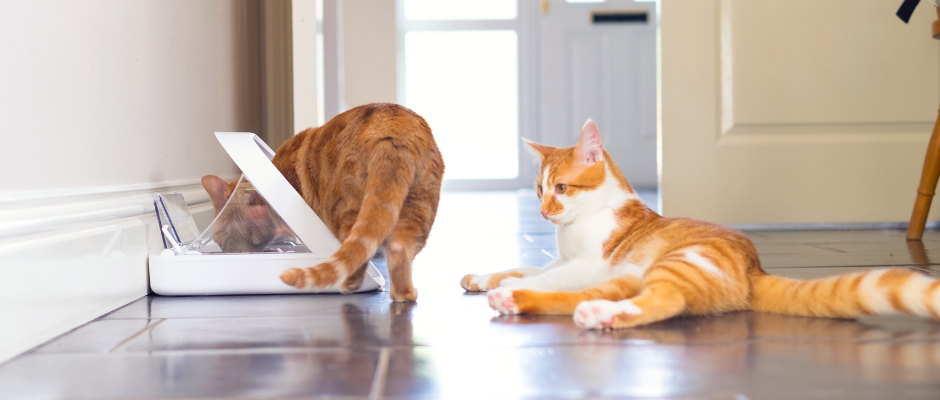What to Consider When Bringing a New Pet into Your Multi-Pet Home
Along with the joys of adopting a new furry family member come a myriad of to-dos and potential challenges—and that’s especially true if you live in a multi-pet home.
So we put together this handy checklist of considerations to keep in mind when you adopt a new pet and bring them into your loving (and pet-filled) home.
1. Get Your New Pet a Microchip
Before you bring your new family member home, consider microchipping your pet. New pets tend to wander and explore their surroundings. This can quickly turn into an emergency should they find their way out of your home or backyard and be unable to find their way back.
By microchipping your pet, you can rest assured that registries like the HomeAgain National Pet Recovery Database and their network of pet rescuers will help to find them should they ever become lost. All it takes is a simple scan of your pet’s microchip, which provides your contact information for a speedy reunion.
They’re much more reliable than tags and collars, which can be removed or fall off and become difficult to read over time. Plus, microchipping pets allows you to sync them with certain devices and get real-time insights into your new pet’s health and activity (more on that below).
2. Start Small
Giving your new pet the freedom to roam the entire house can be overwhelming at first, which is why the Animal Humane Society recommends keeping them in a designated and secure space for at least one week.
Separating new and current pets also helps them get accustomed to each other’s smell without risking an aggressive interaction between them.
Once your pet starts to show signs that they’re comfortable in their new environment, such as coming to you for food or affection, then it’s time to give them the chance to explore. Be sure to stay nearby and block off any off-limit areas so they immediately learn where they can and cannot go.
3. Monitor Short Interactions with Other Pets
Just like people, certain pets adapt more quickly and easily to new surroundings than others, so patience is paramount when bringing a new addition into a multi-pet home. You’ll also want to consider how your current pets will adjust to a new fur friend living in their home.
It’s best to start with brief 5-to-10-minute interactions. Don’t force interactions by bringing the new pet into your current pet’s personal space or favorite spot in the home.
4. Wait to Introduce Your Pet to Friends.
It can be hard to resist the urge to show off your new pet to friends, but doing so too quickly can overwhelm your pet. For the first week or so, try to limit interactions so your new pet only meets and spends time with everyone in the home (including other pets).
When in doubt, follow your pet’s lead; if they’re relaxed and comfortable in the home, then a visitor or two at a time would be okay. But if they’re shy and hesitant, it’s best to wait.
5. Understand How Your Pet Is Feeling.
Perhaps the most challenging dynamic to navigate involves a multi-pet home with different types of animals. To make sure all of your pets are adapting to the new situation, consider using a pet activity tracker like Animo® Classic.
This small device attaches to your dog’s collar and tracks their activity, calories, sleep, and behavior so you can rest assured that they’re living a healthy and balanced lifestyle.
Over time, if the pet activity tracker is showing that your dog isn’t sleeping well or is shaking frequently, which may be a sign of anxiety, then it might be best to reevaluate the interactions between your pets.
6. Eliminate Stressful Interactions Between Pets.
Mealtimes are typically stressful, especially for cats who are made to eat near other pets or share food bowls. Food stealing is another common complication in multi-pet homes, but the good news is that there’s a simple solution: the SureFeed® Microchip Pet Feeder Connect.
Specifically designed for cats and small dogs in multi-pet homes, the feeder syncs with your pet’s microchip and only permits access to that specific pet so you never have to worry about them stealing each other’s food or feeling anxious during mealtimes.
Microchip feeders are especially important if one of your pets requires prescription or diet food. You can track when, how often, and how much food your cat or small dog has consumed. Plus, integrated scales allow for easy, accurate measurement of food, and the bowl cover keeps food fresher, longer. The option to use these devices is just one more benefit of microchipping pets.
There’s a lot to consider when bringing a new addition into an already-pet-filled home, but with preparation, patience, and the proper tools like pet activity trackers and microchip feeders, you can rest assured that your pets will thrive inside the home.
Sure Petcare products are not intended to diagnose, cure, treat or prevent diseases or conditions and does not replace veterinary care.
![<?php echo $store[store_name]; ?> flag](https://media.surepetcare.com/website/images/homepage_tiles/shopping-cart.png)



